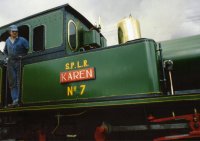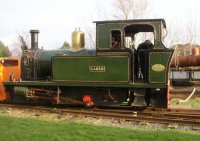Karen
0-4-2 Side Tank Locomotive
Karen was built in 1942 by Peckett of Bristol for the Selukwe Peak Light Railway in Rhodesia (now Zimbabwe). This railway was constructed in the 1920s to carry chrome ore from the Rhodesia Chrome Mines Ltd. workings to the railhead at Selukwe.
Karen had two sister locomotives, Ivy and Mary. The three locomotives were well suited to the task of hauling 70 - 80 ton trains over a six-mile railway with 1 in 45 gradients. The design is closely similar to an equivalent Peckett standard gauge tank engine design: Karen and her sisters have outside frames, whereas the standard gauge versions have the wheels outside the frame. However, the frames and many other parts are common across the two designs.
Having been imported from Africa, Karen was bought by a consortium of Welsh Highland Railway members in 1976, arriving at the WHR two years later.
Restoration was completed in 1983 and the first public steam service was hauled in that year.
After a decade of reliable service, the boiler became due for major overhaul. Karen was withdrawn in 1993, and is presently stored out of service as a static museum exhibit, awaiting its turn for boiler overhaul.
Specifications
| Builder | Peckett and Sons, Bristol | ||
|---|---|---|---|
| Built | 1942 | ||
| Works number | 2024 | ||
| Type | Side tank | ||
| Wheel arrangement | 0-4-2 | ||
| Driving wheel diameter | 30½" | 775mm | |
| Tank capacity | 440 gallons | 2000 l | |
| Heating surface | - | ||
| Boiler pressure | 160 psi | 1.10MPa | |
| Cylinders | Two off, 10" x 15" | 254mm x 381mm | |
| Tractive effort | 6300 pounds | 28.0kN | at 85% boiler pressure |
| Weight | 21 tons | in working order | |
| Maximum axle load | 7 tons | ||
| Arrived W.H.R. | 1978 | ||
| Owners | Consortium of W.H.R. members | ||





